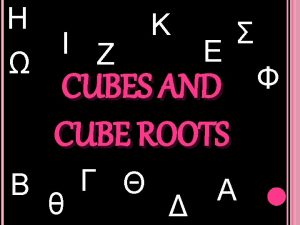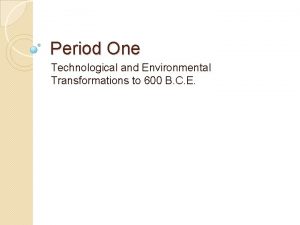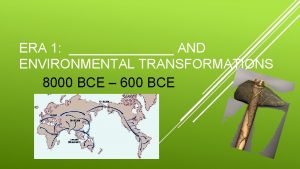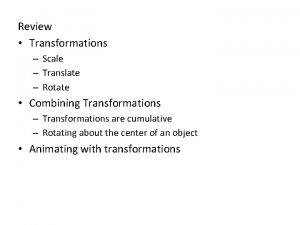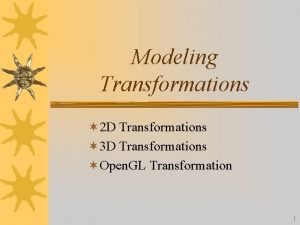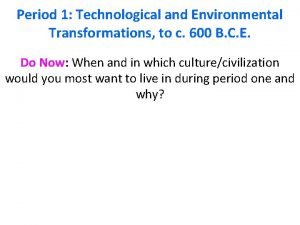Unit One Technological and Environmental Transformations c 8000




















































- Slides: 52

Unit One: Technological and Environmental Transformations (c. 8000 BCE to c. 600 BCE) Chapters 1 -6 Key Concepts: 1. 1 Big Geography and the Peopling of the Earth 1. 2 Neolithic Revolution and Early Agricultural Societies 1. 3 Development and Interactions of Early Agricultural, Pastoral, and Urban Societies

Key Concept 1. 1 Big Geography and the Peopling of the Earth

Key Concept 1. 2 Neolithic Revolution and Early Agricultural Societies

Key Concept 1. 3 Development and Interactions of Early Agricultural, Pastoral, and Urban Societies

Prehistory • The time before written records were kept. • Human beings and our ancestors (hominids) lived on earth for millions of years before the start of history. • Prehistory is divided into three main periods: 1. Paleolithic (Old Stone Age) 2. Mesolithic (Middle Stone Age) 3. Neolithic (New Stone Age)

The Development of Culture **Prehistoric humans were the first to begin developing culture. The most basic definition of culture is: Learned patterns of action The existence of cave paintings proves that culture existed among early humans.

Prehistoric Cave Art

Another Definition of Culture: is a shared, learned, symbolic system of values, beliefs and attitudes that shapes and influences perception and behavior. An abstract "mental blueprint" or "mental code. " Culture is examined by studying behavior, customs, material culture (artifacts, tools, technology), language, etc.

7 Characteristics of Culture • Learned. Process of learning one's culture is called enculturation. • Shared by the members of a society. No "culture of one. " • Patterned. People in a society live and think in ways that form definite patterns. • Mutually constructed through a constant process of social interaction. • Symbolic. Culture, language and thought are based on symbols and symbolic meanings. • Arbitrary. Not based on "natural laws" external to humans, but created by humans according to the "whims" of the society. Example: standards of beauty. • Internalized. Habitual. Taken-for-granted. Perceived as "natural. "

The Agricultural Revolution(s) • Archaeologists and historians believe plant domestication began about 10, 000 years ago among some human groups. This led to the first permanent, or sedentary, villages. • Domestication of animals was also an important part of the Neolithic Revolution. • Several agricultural revolutions occurred at different times throughout the world. Some societies, because of geography, climate, and resource availability, did not develop agriculture. • Calendars were developed to keep track of planting/harvesting seasons.

Regions of the world where agriculture first developed: • Southwest Asia • East Asia • Southeast Asia • Mesoamerica (Evidence indicates independently developed agriculture) • Northeastern America • East Africa (Nile Valley) • West Africa • Southeast Europe • South America (Andes Region) (Evidence indicates agricultural knowledge and technology may have been borrowed from, or spread from other regions. ) Agricultural revolutions occurred in many (but not all) regions of the world between 9000 BCE – 2000 BCE.

Crash Course Episode 1 http: //www. youtube. com/watch? v=Yocja_N 5 s 1 I&list=PLBDA 2 E 52 FB 1 EF 80 C 9&index=1

Origins and Early Spread of Agriculture © 2011, The Mc. Graw-Hill Companies, Inc. All Rights Reserved.


Agriculture and Population Growth © 2011, The Mc. Graw-Hill Companies, Inc. All Rights Reserved.

Early Agricultural Society • Emergence of villages and towns • Discoveries at Çatal Hüyük – a prominent village located in Turkey, occupied 72505400 B. C. E. – Archaeological evidence includes pots, baskets, textiles, leather, stone, metal tools, wood carvings, carpets, beads, and jewelry • Development of crafts – pottery, metallurgy, and textile production © 2011, The Mc. Graw-Hill Companies, Inc. All Rights Reserved.

Neolithic Revolution - domestication of plants and animals begins Villages form, population increases Need for increased food surplus and irrigation arises Job specialization becomes more complex Political organization begins in order to organize labor for large irrigation projects Social classes form and social structures become more complex

The Origins of Urban Life: Civilization • • Craft specialization Social stratification Governance Cultural workers (religious leaders, scribes, etc. ) • Development of the city – a gradual process • Keep in mind: the terms city and civilization come from the same Latin root. © 2011, The Mc. Graw-Hill Companies, Inc. All Rights Reserved.

Civilization - Official Definition: An organized social structure. The main features of early civilizations, according to some historians: • • cities central government religion job specialization (such as scribes, artisans, priests, etc. ) social classes arts and architecture public works a form of writing Other common characteristics of early civilizations: • Polytheism • the use of slave labor • patriarchy

Group Discussion Activity: Think and discuss the term civilization within the context of the study of world history.

• The following slides highlight the development of influential early civilizations – those first civilizations that had a significant impact or contributed to the development of societies beyond their own. Many of these civilizations are often called “foundation civilizations. ” • Remember that pastoral groups also developed in this period, and interactions between different types of societies impacted the unfolding of history.

Mesopotamia • Means “between the rivers, ” (the Tigris and Euphrates) • Modern day Iraq • Sumerians were the earliest urban civilization, located in Mesopotamia. • Later, the Babylonians would build upon Sumerian civilization. © 2011, The Mc. Graw-Hill Companies, Inc. All Rights Reserved. *

Sumerian City-States • City-states developed by c. 4000 BCE • Sumerians dominated the region from c. 3200 BCE to c. 2350 BCE • Monumental religious architecture – ziggurats • Created irrigation systems • Created defensive walls and other strategies for defense against nomadic groups • Kings ruled with absolute power • Priests were also powerful *

• The Babylonians were a Mesopotamian civilization descended from the Sumerians. • The most famous Babylonian king was Hammurabi (c. 1728 – 1686 B. C. E. ) He created the first public, written law code and expanded Babylonian territory in Mesopotamia.

• Hammurabi’s Code is extremely significant because it was the first comprehensive written law code of the ancient, or foundations period. • Hammurabi contributed to the rise and greatness of Babylon, the world's first metropolis. Many relics of Hammurabi's reign (1795 -1750 B. C. E. ) have been preserved, including the law code. • The code is the earliest known example of a ruler proclaiming publicly to his people an entire body of laws, arranged in orderly groups, so that all literate men could read and know what was required of them. • The code was carved upon a black stone monument, eight feet high, and clearly intended to be reared in public view.

Detail of the top of the stele, depicting Hammurabi and Shamash.

Selections from Hammurabi’s Code Analyzing the evidence: what can we learn about Babylonian society from this source? Discuss with a partner and jot down a list. Question: What kind of historical source is Hammurabi’s code?

6. If a man has stolen goods from a temple, or house, he shall be put to death; and he that has received the stolen property from him shall be put to death. 8. If a patrician has stolen ox, sheep, ass, pig, or goat, whether from a temple, or a house, he shall pay thirtyfold. If he be a plebeian, he shall return tenfold. If the thief can not pay, he shall be put to death. 22. If a man has committed highway robbery and has been caught, that man shall be put to death. 23. If the highwayman has not been caught, the man that has been robbed shall state on oath what he has lost and the city or district governor in whose territory or district the robbery took place shall restore to him what he has lost.

195. If a son has struck his father, his hands shall be cut off. 196. If a man has knocked out the eye of a patrician, his eye shall be knocked out. 197. If he has broken the limb of a patrician, his limb shall be broken. 198. If he has knocked out the eye of a plebeian or has broken the limb of a plebeian’s servant, he shall pay one mina of silver. 199. If he has knocked out the eye of a patrician’s servant, or broken the limb of a patrician’s servant, he shall pay half his value. 200. If a patrician has knocked out the tooth of a man that is his equal, his tooth shall be knocked out. 201. If he has knocked out the tooth of a plebeian, he shall pay one-third of a mina of silver.

229. If a builder has built a house for a man, and has not made his work sound, and the house he built has fallen, and caused the death of its owner, that builder shall be put to death. 230. If it is the owner’s son that is killed, the builder’s son shall be put to death. 231. If it is the slave of the owner that is killed, the builder shall give slave for slave to the owner of the house. 232. If he has caused the loss of goods, he shall render back whatever he has destroyed. Moreover, because he did not make sound the house he built, and it fell, at his own cost he shall rebuild the house that fell.

Mesopotamian Empires, 1800 -600 B. C. E. © 2011, The Mc. Graw-Hill Companies, Inc. All Rights Reserved. *

Technological Development in Mesopotamia 1. Bronze (copper with tin), ca. 4000 B. C. E. ❑ Military, agricultural applications 2. Iron, ca. 1000 B. C. E. ❑ Cheaper and more durable than bronze 3. Wheel, boats, ca. 3500 B. C. E. (Shipbuilding increased trade and the development of early trade networks. ) 4. Development of cuneiform writing © 2011, The Mc. Graw-Hill Companies, Inc. All Rights Reserved. *

A Summary of Archaeological Periods 8000 -- 4000 BCE Neolithic Period 4000 -- 3150 BCE Chalcolithic Period * 3150 -- 2900 BCE Early Bronze Age I 2900 -- 2600 BCE Early Bronze Age II 2600 -- 2300 BCE Early Bronze Age III 2200 -- 1950 BCE Middle Bronze Age I 1950 -- 1550 BCE Middle Bronze Age II 1550 -- 1400 BCE Late Bronze Age I 1400 -- 1200 BCE Late Bronze Age II 1200 -- 1000 BCE Iron Age I 1000 -- 586 BCE Iron Age II Q: What is this method of organizing early history based on? *Chalcolithic is the name given to the period in the Near East (a. k. a. Middle East) and Europe after the Neolithic and before the Bronze Age, between about 4500 and 3500 BCE. This period has the earliest evidence for complex societies, the location of cemeteries outside of settlements, craft specialization in copper tool production, ivory, and ceramics. The word is from the Greek for copper (chalcos) and stone (lithos).

Ancient Egypt: The Gift of the Nile ■ ■ ■ -Gradual, predictable flooding -“Gift of the Nile” -Developed Hieroglyphics -Built pyramids -Traded with Mesopotamia, Nubia, early Greek civilization © 2011, The Mc. Graw-Hill Companies, Inc. All Rights Reserved. *

The Early Hebrews ■ ■ ■ According to Hebrew scripture, Abraham migrated to northern Mesopotamia ca. 1850 B. C. E. Parallels between early biblical texts, code of Hammurabi Scriptures state Hebrews under Moses go to Palestine, ca. 1300 B. C. E. ❑ ■ On-going conflict with indigenous populations King David (1000 -970 B. C. E. ) and Solomon (970 -930 B. C. E. ) © 2011, The Mc. Graw-Hill Companies, Inc. All Rights Reserved. *

Moses and Monotheism ■ ■ Hebrews shared polytheistic beliefs of other Mesopotamian civilizations Moses introduced monotheism, belief in single god ❑ ❑ ❑ Denied existence of competing parallel deities Personal god: reward and punishment for conformity with revealed law The Torah (“doctrine or teaching”) © 2011, The Mc. Graw-Hill Companies, Inc. All Rights Reserved. *

The Phoenicians ■ ■ City-states along Mediterranean coast after 3000 B. C. E. Extensive maritime trade ❑ ■ Dominated Mediterranean trade, 1200 -800 B. C. E. Development of alphabet symbols ❑ ❑ Simpler alternative to cuneiform Spread of literacy © 2011, The Mc. Graw-Hill Companies, Inc. All Rights Reserved. *

Early Migrations – Indo-European and Bantu pastoral peoples Indo-European Migrations ■ ■ Common roots of many languages of Europe, southwest Asia, India Implies influence of a single Indo-European people ❑ ■ Probable original homeland: modern-day Ukraine and Russia, 4500 -2500 B. C. E. Domestication of horses, use of Sumerian weaponry allowed them to spread widely © 2011, The Mc. Graw-Hill Companies, Inc. All Rights Reserved. *

Indo-European Migrations 3000 -1000 B. C. E. © 2011, The Mc. Graw-Hill Companies, Inc. All Rights Reserved. *

Implications of Indo-European Migration ■ ■ Hittites migrate to central Anatolia, ca. 1900 B. C. E. , later dominate Babylonia Influence on trade ❑ ❑ ❑ Horses, chariots with spoked wheels Iron Migrations to western China, Greece, Italy also significant © 2011, The Mc. Graw-Hill Companies, Inc. All Rights Reserved. *

Harappan Society and Its Neighbors, ca. 2000 B. C. E. © 2011, The Mc. Graw-Hill Companies, Inc. All Rights Reserved. *

Harappan Society and Culture ■ Evidence of social stratification ❑ ■ ■ ■ Dwelling size, decoration Harappan civilization: influence on later Indian culture Statues, figurines, and illustrations reflect a tradition of art and metallurgy Venerated goddesses of fertility © 2011, The Mc. Graw-Hill Companies, Inc. All Rights Reserved. *

Mysterious End of Harappan Civilization ■ Reasons for disappearance unclear ❑ ❑ ❑ Excessive deforestation, loss of topsoil Earthquakes? Flooding? ■ ■ ■ Evidence of unburied dead Disappearance by 1500 B. C. E. Harappan traditions survived – agricultural practices, religious beliefs, and urban traditions © 2011, The Mc. Graw-Hill Companies, Inc. All Rights Reserved. *

The Early Aryans ■ ■ Migrated into South Asian subcontinent as part of Indo-European migrations. Pastoral economy: sheep, goats, horses, cattle ❑ ■ Cattle not sacred until many centuries later Religious and literary works: the Vedas ❑ ❑ ❑ Sanskrit: sacred tongue Prakrit: everyday language, evolved into Hindi, Urdu, Bengali Four Vedas (wisdom), most important Rig Veda ■ 1028 hymns to Aryan gods © 2011, The Mc. Graw-Hill Companies, Inc. All Rights Reserved.

Oracle Bones and Early Chinese Writing ■ Used for communicating with spirit world, determining future ❑ ❑ ■ ■ Question written on animal bones, turtle shells Then heated over fire; cracks examined for omens Early archaeological evidence of Chinese writing Evolution of Chinese script ❑ Pictograph to ideograph © 2011, The Mc. Graw-Hill Companies, Inc. All Rights Reserved. *

Oracle Bone from Shang Dynasty © 2011, The Mc. Graw-Hill Companies, Inc. All Rights Reserved. *

Early Mesoamerican Societies © 2011, The Mc. Graw-Hill Companies, Inc. All Rights Reserved.

Origins of Mesoamerican Societies ■ Migration across Bering land bridge? ❑ ■ ■ ■ Probably 13, 000 B. C. E. , perhaps earlier By sea from Asia? By 9500 B. C. E. reached southernmost part of South America Hunter/gatherer societies ❑ Evolve into agricultural societies © 2011, The Mc. Graw-Hill Companies, Inc. All Rights Reserved. *

Olmec – The Foundation Civilization of Central America ■ ■ ■ 1200 -100 B. C. E. The “rubber people” Ceremonial centers ❑ ■ San Lorenzo, La Venta, Tres Zapotes Olmec heads ❑ ❑ ❑ Up to 10 ft. tall, 20 tons Transported by dragging, rolling on logs 1000 workers per head © 2011, The Mc. Graw-Hill Companies, Inc. All Rights Reserved. *

Olmec Society ■ ■ -Probably authoritarian in nature -Large class of conscripted laborers to construct ceremonial sites ❑ Also tombs for rulers, temples, pyramids, drainage systems © 2011, The Mc. Graw-Hill Companies, Inc. All Rights Reserved. *

Mysterious Decline of Olmecs ■ ■ ■ ■ Ceremonial centers destroyed No evidence of warfare Revolution? Civil war? Natural disaster? Resource depletion? All of the above? © 2011, The Mc. Graw-Hill Companies, Inc. All Rights Reserved. *

Andean Societies ■ ■ Migration into South America ca. 12, 000 B. C. E. Climate improves ca. 8000 B. C. E. Largely independent from Mesoamerica Highly individualized due to geography © 2011, The Mc. Graw-Hill Companies, Inc. All Rights Reserved. *
 Which is one limitation to technological design
Which is one limitation to technological design Night structure
Night structure Mh 605
Mh 605 8000/600
8000/600 Iso8000
Iso8000 John's parents deposited $1000
John's parents deposited $1000 Dsc 8000 perkin elmer
Dsc 8000 perkin elmer Polycom vsx 700
Polycom vsx 700 Cube root of 8000
Cube root of 8000 8010/3 karsinom nos ne demek
8010/3 karsinom nos ne demek A deflated hot air balloon weighs a total of 8000 n
A deflated hot air balloon weighs a total of 8000 n Tsq 8000
Tsq 8000 Apx 8000 xe
Apx 8000 xe Dedicated analytical solution
Dedicated analytical solution 8000-3700
8000-3700 Solemate fpx
Solemate fpx What change began the neolithic age, about 8000 b.c.e.? *
What change began the neolithic age, about 8000 b.c.e.? * Iso 26000 sa 8000
Iso 26000 sa 8000 Sony xvs 8000
Sony xvs 8000 01 8000 911 119
01 8000 911 119 Mlc 8000
Mlc 8000 4000/8000
4000/8000 Si-8000
Si-8000 Sa 8000 standardı nedir
Sa 8000 standardı nedir 20000000/8000
20000000/8000 Ds-8000
Ds-8000 Gentlesilence lux 8000b
Gentlesilence lux 8000b Sally invests 8000 in a savings account
Sally invests 8000 in a savings account Dois frascos de igual volume mantidos
Dois frascos de igual volume mantidos 350000/8000
350000/8000 Confidential presentation disclaimer
Confidential presentation disclaimer Polycom hdx 8000 microsoft teams
Polycom hdx 8000 microsoft teams Technology gap model
Technology gap model Scientific vs technical
Scientific vs technical One empire one god one emperor
One empire one god one emperor One one little dog run
One one little dog run One king one law one faith
One king one law one faith One empire one god one emperor
One empire one god one emperor One ford plan
One ford plan See one do one teach one
See one do one teach one See one, do one, teach one
See one, do one, teach one Studiendekanat uni bonn
Studiendekanat uni bonn Asean tourism strategic plan
Asean tourism strategic plan Asean one vision one identity one community
Asean one vision one identity one community Unit one lesson one
Unit one lesson one Lesson 1 my life goals
Lesson 1 my life goals Unit 10, unit 10 review tests, unit 10 general test
Unit 10, unit 10 review tests, unit 10 general test Visvesvaraya technological university nagpur
Visvesvaraya technological university nagpur Technology discontinuity
Technology discontinuity Technology risk definition
Technology risk definition Technological modelling
Technological modelling Technological leader
Technological leader Design process
Design process








